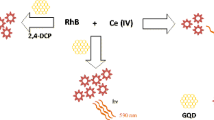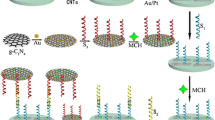Abstract
We report on a highly sensitive and selective electrochemiluminescence (ECL) based method for the determination of pentachlorophenol (PCP). It is based on a new hybrid material composed of CdS quantum dots (QDs), graphene, and carbon nanotubes (CNTs), and uses peroxodisulfate as the coreactant. The use of this system results in a nearly 18-fold increase in ECL intensity. On interaction between PCP and the QDs, a decrease in ECL intensity is observed at PCP in a concentration as low as 1.0 pM and over a wide linear range (from 1.0 pM to 1.0 nM). The method is hardly affected by other chlorophenols and nitrophenols, and the electrode can be recycled.

ᅟ




Similar content being viewed by others
References
Shiu WY, Ma KC, Varhanickova D, Mackay D (1994) Chlorophenols and alkylphenols–a review and correlation of environmentally relevant properties and fate in an evaluative environment. Chemosphere 29:1155–1224
Keith LH, Telliard WA (1979) Priority pollutants I-a perspective view. Environ Sci Technol 13:416–423
International Agency for Research on Cancer (1991) International Agency for Research on Cancer, Occupational exposures in insecticide application, and some pesticides, Lyon
Leblance YG, Gilbert R, Hubert J (1999) Determination of pentachlorophenol and its oil solvent in wood pole samples by SFE and GC with postcolumn flow splitting for simultaneous detection of the species. Anal Chem 71:78–85
Mardones C, Palma J, Sepulveda C, Berg A, Baer DV (2003) Determination of tribromophenol and pentachlorophenol and its metabolite pentachloroanisole in Asparagus officinalis by gas chromatography/mass spectrometry. J Sep Sci 26:923–926
Tayal A, Das L, Kaur I (1999) Biodegradation of pentachlorophenol (PCP) by white rot fungal strains screened from local sources and its estimation by high-performance liquid chromatography. Biomed Chromatogr 13:220–224
Fischer W, Bund O, Hauck HE (1996) Thin-layer chromatographic analysis of phenols on TLC aluminium sheets RP-18 F 254s. J Anal Chem 354:889–891
Gremaud E, Turesky RJ (1997) Rapid analytical methods to measure pentachlorophenol in wood. J Agric Food Chem 45:1229–1233
Lei JP, Ju HX (2011) Fundamentals and bioanalytical applications of functional quantum dots as electrogenerated emitters of chemiluminescence. Trends Anal Chem 30:1351–1359
Kanwal S, Fu XH, Su XG (2010) Size dependent active effect of CdTe quantum dots on pyrogallol-H2O2 chemiluminescence system for chromium(III) detection. Microchim Acta 169:167–172
Jie GF, Zhang JJ, Wang DC, Cheng C, Chen HY, Zhu JJ (2008) Electrochemiluminescence immunosensor based on CdSe nanocomposites. Anal Chem 80:4033–4039
Wang Y, Lu J, Tang LH, Chang HX, Li JH (2009) Graphene oxide amplified electrogenerated chemiluminescence of quantum dots and its selective sensing for glutathione from thiol-containing compounds. Anal Chem 81:9710–9715
Liu X, Zhang Y, Lei J, Xue Y, Cheng L, Ju H (2010) Quantum dots based electrochemiluminescent immunosensor by coupling enzymatic amplification with self-produced coreactant from oxygen reduction. Anal Chem 82:7351–7356
Wu HY, Ding ZY, Peng M, Song QJ (2012) Quantum dot induced phototransformation of 2,4-dichlorophenol, and its subsequent chemiluminescence reaction. Microchim Acta 178:203–210
Bae Y, Myung N, Bard AJ (2004) Electrochemistry and electrogenerated chemiluminescence of CdTe nanoparticles. Nano Lett 4:1153–1161
Dirk M, Guldi GM, Aminur R, Vito S, Nicholas AK, Davide B, Maurizio P (2006) CNT − CdTe versatile donor − acceptor nanohybrids. J Am Chem Soc 128:2315–2323
Jie GF, Huang HP, Sun XL, Zhu JJ (2008) Electrochemiluminescence of CdSe quantum dots for immunosensing of human prealbumin. Biosens Bioelectron 23:1896–1899
Kim KS, Zhao Y, Jang H, Lee SY, Kim JM, Kim KS, Ahn JH, Kim P, Choi JY, Hong BH (2009) Large-scale pattern growth of graphene films for stretchable transparent electrodes. Nature 457:706–710
Geim AK (2009) Graphene: status and prospects. Science 324:1530–1534
Katsnelson MI (2007) Graphene: carbon in two dimensions. Mater Today 10:20–27
Ding SN, Xu JJ, Chen HY (2006) Enhanced solid-state electrochemiluminescence of CdS nanocrystals composited with carbon nanotubes in H2O2 solution. Chem Commun 34:3631–3633
Ling LL, Liu KP, Yang GH, Wang CM, Zhang JR, Zhu JJ (2011) Fabrication of graphene–quantum dots composites for sensitive electrogenerated chemiluminescence immunosensing. Adv Funct Mater 21:869–878
Wang XF, Zhou Y, Xu JJ, Chen HY (2009) Signal-on electrochemiluminescence biosensors based on CdS–carbon nanotube nanocomposite for the sensitive detection of choline and acetylcholine. Adv Funct Mater 19:1444–1450
Wang J, Han HY, Jiang XC, Huang L, Chen LN, Li N (2012) Quantum dot-based near-infrared electrochemiluminescent immunosensor with gold nanoparticle-graphene nanosheet hybrids and silica nanospheres double-assisted signal amplification. Anal Chem 84:4893–4899
Tang LH, Zhu YH, Yang XL, Sun JJ, Li CZ (2008) Self-assembled CNTs/CdS/dehydrogenase hybrid-based amperometric biosensor triggered by photovoltaic effect. Biosens Bioelectron 24:319–323
Yoo EJ, Okata T, Akita T, Kohyama M, Nakamura J, Honma I (2009) Enhanced electrocatalytic activity of Pt subnanoclusters on graphene nanosheet surface. Nano Lett 9:2255–2259
Lu J, Do I, Drzal LT, Worden RM, Lee I (2008) Nanometal-decorated exfoliated graphite nanoplatelet based glucose biosensors with high sensitivity and fast response. ACS Nano 2:1825–1832
William S, Hummers JR, Richard EO (1958) Preparation of graphitic oxide. J Am Chem Soc 80:1339
Yang SL, Liu XY, Zeng XD, Xia BY, Gu JP, Luo SL, Mai NN, Wei WZ (2010) Fabrication of nano-copper/carbon nanotubes/chitosan film by one-step electrodeposition and its sensitive determination of nitrite. Sensors Actuators B 145:762–768
Chen LY, Tang YH, Wang K, Liu CB, Luo SL (2011) Direct electrodeposition of reduced graphene oxide on glassy carbon electrode and its electrochemical application. Electrochem Commun 13:133–137
Michael K, Gary H (2010) Influence of selective nucleation on the one step chemical bath deposition of CdS/ZnO and CdS/ZnS composite films. Chem Mater 22:5483–5491
Jie GF, Li LL, Chen C, Xuan J, Zhu JJ (2009) Enhanced electrochemiluminescence of CdSe quantum dots composited with CNTs and PDDA for sensitive immunoassay. Biosens Bioelectron 24:3352–3358
Yamashita K, Yamazaki-Nishida S, Harima Y, Segawa A (1991) Direct current electrogenerated chemiluminescent microdetermination of peroxydisulfate in aqueous solution. Anal Chem 63:872–876
Zheng L, Chi Y, Dong Y, Lin J, Wang B (2009) Electrochemiluminescence of water-soluble carbon nanocrystals released electrochemically from graphite. J Am Chem Soc 131:4564–4565
Li JX, Yang LX, Luo SL, Chen BB, Li J, Lin HL, Cai QY, Yao SZ (2010) Polycyclic aromatic hydrocarbon detection by electrochemiluminescence generating Ag/TiO2 nanotubes. Anal Chem 82:7357–7361
Wang HF, He Y, Ji TR, Yan XP (2009) Surface molecular imprinting on Mn-doped ZnS quantum dots for room-temperature phosphorescence optosensing of pentachlorophenol in water. Anal Chem 81:1615–1621
Mufeed AA, Harmon HJ (2005) Spectrophotometric detection of pentachlorophenol (PCP) in water using immobilized and water-soluble porphyrins. Biosens Bioelectron 20:1595–1601
Tang CL, Meng GW, Huang Q, Huang ZL, Zhang XR, Wang ML (2012) A silica xerogel thin film based fluorescent sensor for pentachlorophenol rapid trace detection. Sensors Actuators B 171:332–337
Jiang XH, Yang M, Meng YJ, Jiang W, Zhan JH (2013) Cysteamine-modified silver nanoparticle aggregates for quantitative SERS sensing of pentachlorophenol with a portable Raman spectrometer. ACS Appl Mater Interfaces. doi:10.1021/am401718p
Wu YH (2009) Nano-TiO2 dihexadecylphosphate based electrochemical sensor for sensitive determination of pentachlorophenol. Sensors Actuators B 137:180–184
Li CC, Kang Q, Chen YF, Li JX, Cai QY, Yao SZ (2010) Electrochemiluminescence of luminol on Ti/TiO2 NT electrode and its application for pentachlorophenol detection. Analyst 135:2806–2810
Acknowledgment
This work was supported by the National Natural Science Foundation of China (51178173, 51202065, 51078129), Innovation Research Team in University (IRT1238), Program for New Century Excellent Talents in University (11–0126), the Key Program of National Natural Science Foundation of China (51238002), and Hunan Province graduate student scientific research innovation plan (No. 521298769).
Author information
Authors and Affiliations
Corresponding author
Additional information
Jiesheng Liang and Shanli Yang contributed equally
Electronic supplementary material
Below is the link to the electronic supplementary material.
ESM 1
(DOC 3854 kb)
Rights and permissions
About this article
Cite this article
Liang, J., Yang, S., Luo, S. et al. Ultrasensitive electrochemiluminescent detection of pentachlorophenol using a multiple amplification strategy based on a hybrid material made from quantum dots, graphene, and carbon nanotubes. Microchim Acta 181, 759–765 (2014). https://doi.org/10.1007/s00604-013-1081-9
Received:
Accepted:
Published:
Issue Date:
DOI: https://doi.org/10.1007/s00604-013-1081-9




